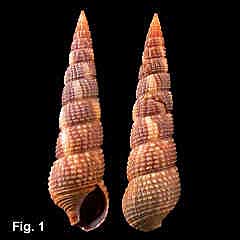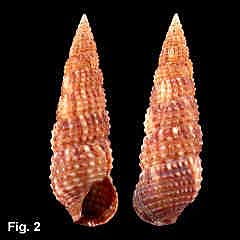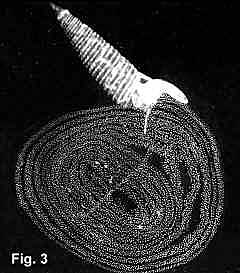|
|
|
|
|
Cacozeliana granaria (Kiener, 1842) Description: Shell variable in height to width ratio. Teleoconch of 10-12 whorls in adult shells. Spire whorls sculptured with 3-6 rows of circular or spirally elongate nodules, sometimes with weak spiral threads between, often aligned on weak axial folds. Body whorl with 4-6 beaded spirals above the periphery, beads sometimes becoming obsolete on lower ribs; base with about 5 unbeaded ribs, varying from weak to strong. Sometimes a weak varix present as a low, broad fold on dorsal surface of body whorl. Columella smooth, body whorl expanded, outer lip thin and smooth internally. Anterior canal very short; posterior canal well defined in mature shells. Colour light to dark brown with irregular white axial splashes. Operculum corneous. Size: Up to 17 mm in length in NSW, up to 28 mm in WA. Distribution: Endemic to Australia; Alexandra Head, near Mooloolaba, Queensland, around southern Australia and Tasmania to Point Cloates, near Exmouth Gulf, WA. Habitat: In sea grass and in sand in estuaries, and under rocks in silty situations of moderately exposed coasts. Abundant. Comparison: See C. icarus. Synonymy: Cerithium lacertinum Gould, 1861 has been used for this species in eastern Australia, on the basis that the eastern shells are shorter and broader and with more closely packed beading than shells from southern Australia. However, there is as large a variation in shape and sculpture within the eastern Australian shells as there is between eastern and southern populations, so the distinction is not justified. Remarks: The anatomy has been described by Houbrick (1993) and the spawn and early life history by Murray (1969). Sexes are separate. After fertilization, the female deposits an egg-packed thread in a closely wound spiral. The spiral is roughly circular, about 20 mm in diameter, consisting of about a dozen turns of the thread. The thread is transparent, containing hundreds of white, spherical eggs, each about 0.085 mm in diameter. After about 12 days veligers hatch from the egg mass and entered the plankton. Fig. 1: Port Hacking, NSW (C.327938) Fig. 2: Gunnamatta Bay, NSW (C.321001) Fig. 3: Egg mass (Photo Murray, 1969) |


